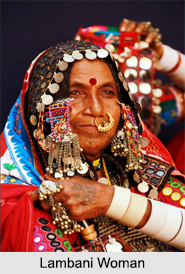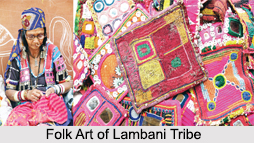 The Lambanis are a Pan-Indian tribe which is found in every sector of the county. They have descendants traced from both the Aryan and Dravidian origins. They inhabit mainly from the Indian states such as Andhra Pradesh and Maharashtra. Initially they belong from the state of Rajasthan. They are a class of people who describe themselves as “Banjaras†or “Gypsies†who travel from place to place. They are also called the “Gypsies of India†in North India. They are popularly highlighted for their vibrant appearance, colorful dresses, Folk bangles and ornaments.
The Lambanis are a Pan-Indian tribe which is found in every sector of the county. They have descendants traced from both the Aryan and Dravidian origins. They inhabit mainly from the Indian states such as Andhra Pradesh and Maharashtra. Initially they belong from the state of Rajasthan. They are a class of people who describe themselves as “Banjaras†or “Gypsies†who travel from place to place. They are also called the “Gypsies of India†in North India. They are popularly highlighted for their vibrant appearance, colorful dresses, Folk bangles and ornaments.
History of the Lambani Tribe
Origin of the Lambanis has always been a burning debate topic. The Lambanis of India are said to have great relevance with the romani gypsies of Middle East countries and Eastern Europe historically. A resemblance of culture and tradition has been moving towards a harmonious fraternity in the world amongst ethnic communities. There are near about 60 million Lambanis in India and 40 million Romani Gypsies in the world who are living a glorious history.
Distribution of the Lambani Tribe
Majority of the Lambani tribe or Banjara communities are resided in Telangana and Andhra Pradesh states where they speak Telugu with their own dialect. In the state of Karnataka, they are scattered in northern parts. Karnataka is known to have the largest population of Lambanis.
 Culture of the Lambani Tribe
Culture of the Lambani Tribe
The culture of the Banjaras or Lambani people tends to have adopted professions and languages. It is distinct from other existential tribal languages of Rajasthan. They wear dresses with mirrors for protecting themselves from Wild animals. Dresses with mirrors are an important and authentic identification of the lambanis. After independence they were put in the list scheduled castes by the then chief minister of Karnataka. Their conditions have not changed since the independence. They are unaware of modernity and technologies for which they have been devoid of any sort of development. They are still unclean, poor, unemployed and face health problems.
Although, there are particular schemes meant for the development of the scheduled caste but they did not availed any such thing. An insight of their culture contains religion traditions, benefits, habits, problems faced during child birth and marriages do not view any feminine point of view. The dress, ornaments and right for property of women, and domestic violence faced by them form a vivid part of the Lambani tribes which need recognition.
The women work with their significant male counterparts shouldering responsibilities of the household. They trade in hens, eggs, vegetables, milk and earn the livelihood apart from the activities of construction work, agriculture and so on. They are significant migrators travelling from one place to another for improving their financial conditions and earn a livelihood. The women hold great responsibilities of whole family but they are not counted in the chores when it comes to decision making. This makes them feel weak, dependent and insignificant.
Dresses of the Lambani Women
The women of Lambani tribe are variant and colorful when it comes to dressing up in their authenticity. They wear decorated fabrics or clothes. Jewellery makes an essential part of their lifestyle. They wear it every time. They wear finger rings, bracelets and bangles made up of animal bones, silver and brass. Big nose pins are a staple of the lambani women. They adorn their hair with flowers and balls. Mostly, the women wear thick aprons that are interwoven or embroidered with cotton threads and needle wear. The apron remains suspended from downwards while the bodice make up the upper part.
Dresses of the Lambani Men
The men of the Lambani Tribe wear a coarse turban that forms the headgear. They are mostly dressed in tight breeches extending a few inches to below the knees. The men also wear jewellery mostly around their neck.
Jewellery of the Lambani Tribe
The lambani women never get exhausted of wearing heavy jewellery. They have specific ornaments for specific occasion. The jewelleries are described below:
•The ornament of head is known as Chotla. It includes bunch of hair ties made of silver. It is used by married women which consists of topy, ghugri, adi sankali and kaddi. The topli is an ornament worn by every Lambadi women without any age restraint.
•The ornaments for nose are worn only after marriages. It is known as Bhuria. It is made up of phule as a silver pin and gold.
•The ornaments for ears are known as Kniya which is a silver ornament. It is used by women after marriage and are presented as a gift to the bride.
•The ornaments for neck are given by the parents of the bride during her marriage. It includes Rapyar, chhed, Hansli and Wankya haar.
•The ornaments for arms are known as Baju bandh kasotiya and Bachhela. The ornaments for forearms are known as Matli kangan which is made up of metals. The Baliya pair is a horn bangle that covers the whole forearms of married women.
•The ornaments for fingers are of three kinds of finger rings. They are known by the name iti or winte made up of silver coin on top, phula another finger ring made up of four old coins of Nizam Government arranged in a floral shape and Sharbari, a finger ring made of silver worn in the thumb.
•The ornaments of leg include various kinds of anklets known as Ghode, Khaus, Jhanzariya, Wankdi and Kasse.
Festivals of the Lambani Tribe
The Lambanis also celebrate similar festivals like other communities. They give a lot of importance to the Teej festival and celebrate it in a grand scale. It is celebrated during Dusshera. Generally, it is considered as a festival for the unmarried girls who pray for a better groom. The girls sow seeds in bowls made of bamboo and water it three times a day. It is celebrated throughout nine days. If the sprouts grow up to become thick, it is considered as a good omen for the future groom. The bowls containing seedlings are kept in a place prominently, and the girls dance and sing circling the seedling bowl.
Another festival of the Lambani Tribe is Holi. This is also celebrated in a grand scale by them. They have professional singers belonging to the community knows as Gajugonia who use "Sarangi" , a musical instrument for the occasion. Apart from the popular festivals of India, they have their traditional or folk festivals which are celebrated with great vigor and enthusiasm.
Ugadi is a folk festival of the Lambani tribe which is highly popular among them. They are pious people who hold religious festivals with great significance. The family deities are revered to a big extent. They share few Hindu religious views and consider Lord Tirupati as the family deity. They save their money for over years to visit and worship Lord of the seven hills which they address as Balaji. Just like any other tribal communities, it is in their nature to dance and perform music as an integral part of the celebrations.
Marriages of the Lambani Tribe
A lambani or Banjara marriage has been celebrated as an additional social festival. At the first day of wedding, Liquor is dispersed freely when the family and relatives of the bridegroom are welcomed. They are cordially welcomed with an offering of nuts and betel leaves. During the marriage, special norms and customs belonging to their tribe are followed. A square silver ornament known as “Bottu†by them is tied around the bride"s neck. The bride and the groom exchange seven holy balls made of ghee, sugar and rice. Later to that, the couple chronologically does another seven rounds of pounding grain with pestles. The whole area echoes to sound of the music sung by women in chorus. They bride is usually shy and taunted by all. Every eye gets misted when the bride leaves her home and goes with her husband to her new home. The lambanis prefer marriages within their community so that the community can expand.
 Art of the Lambani Tribe
Art of the Lambani Tribe
The folk art of the Lambani people includes Rangoli, Emroidery, dance, music, tattooing and Painting. Tattooing and embroidery holds superior significance in the community. The women specialize in preparing the lepo embroidery over clothes by inter vowing pieces of glasses in colorful clothes. They have a craft known as “Sandur Lambani Craft†which has got a registered geographic indication tag. It enables the people of the Lambani tribe to market themselves exclusively by that name.
Language of the Lambani Tribe
They speak a Banjari language known as "Goar-boli" belonging to the Indo-Aryan groups. The language has no recorded history and script. Although, the community is learning local Indian languages which in turn has resulted in losing their original dialect gradually. The have bi-lingual or multi-lingual languages and adopting the surrounding language predominantly.





















